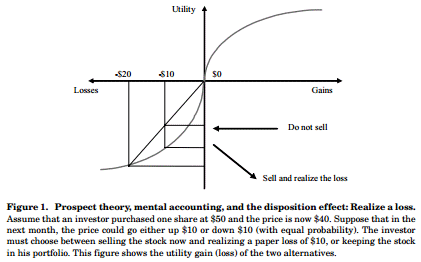
Behavioural Finance covers a wide area of human behaviour in the context of financial decisions. The points below are a very high-level description of the ones most relevant for the Rosevalley portfolios.
Prospect Theory
One of the central concepts in Behavioural Finance is Prospect Theory. Prospect Theory argues that the classical model of decision making (expected utility theory) is not a very good descriptor of the way decisions are actually being made by human beings.
The theory shows how people weight gains and losses and probabilities and certainties in different ways.
The result of relevance to investors is an explanation for why people get less positive utility from a gain of certain value, than the negative utility from a loss of equivalent value.
It also introduces the concept of Reference Dependency whereby people always measure their financial position (and other sensory positions, e.g. heat and light) from a reference point.
Mental Accounting
Mental accounting is an economic concept established by economist Richard H. Thaler, which contends that individuals classify different buckets of personal funds differently and consider them non-fungible, and therefore are prone to irrational decision-making in their spending and investment behavior.
Example: a person may have a low-yielding bank account in which he/she saves money for a vacation, while at the same time carrying a credit card debt that is being rolled over every month at a high interest rate.
The carry-over to the stock market is that people tend to view each stock they have purchased as a separate account, and therefore consider the gain or loss on that stock separately – as opposed to evaluating the gains or losses across the portfolio as the more traditional portfolio theory would advise.
Disposition effect
The combination of Prospect Theory and Mental Accounting leads to the Disposition Effect:
Because a loss is felt more intensely than a gain, people tend to be reluctant to sell stocks at a loss – instead they are hoping ‘things will turn around’
Similarly, they tend to sell stocks at a profit earlier than they rationally should
The Disposition Effect is thus related to the concept of Reference Price: what is important to the decision to sell a stock is not the fair value (however defined), but the Reference Price of the owner.
The Reference Price shows up in other applications of Prospect Theory, but for stock prices it is the price at which the investor has purchased the stock.
The decision to sell or keep the stock is thus informed not by the (perceived or real) fair value of the stock relative to its market price, but rather by the paper gains or losses relative to the Reference Price.
Impact on stock prices
The Disposition Effect and the concept of Reference Price affect stock prices in the following manner:
Imagine an event that changes the fair value of a stock downward. Efficient Market Theory would suggest this information will be captured immediately in the stock price, so the stock will adjust immediately to its new, lower value.
However, Behavioural Finance says investors are reluctant to sell their stock at a loss. Hence, as the price starts to go down, investors don’t sell as much as they rationally should, slowing down the price decline.
The magnitude of the slow down is proportional to the gap between the Reference Price and the current price.
Over time, as trades are done at lower prices, the average Reference Price across investors in the market will be lower. The net effect is that the market price will drift slowly downward to the new fair value, rather than immediately as Efficient Market Theory would suggest.
A similar argument explains why stock prices slowly drift upward to a new, higher, fair value in case of positive news.
Rosevalley is taking advantage of this systematic biased behaviour
The theory suggests (and empirical evidence supports) that one should buy stocks with a large positive gap between the current market price and the Reference Price, and sell stocks with a large negative gap.
The maths shows that the largest performance can be achieved if the holding period equals the Half-time of the drift of the Reference Price toward the fair value.
The obvious problem here is that the Reference Price and the Half-time are not readily observable variables.
However, the Rosevalley team has developed a proprietary proxy for the Reference Price Gap, which is being used to construct the portfolios.
As for the Half-time of the closure of the gap, empirical evidence shows this time frame to be in the area of 6-12 months.
